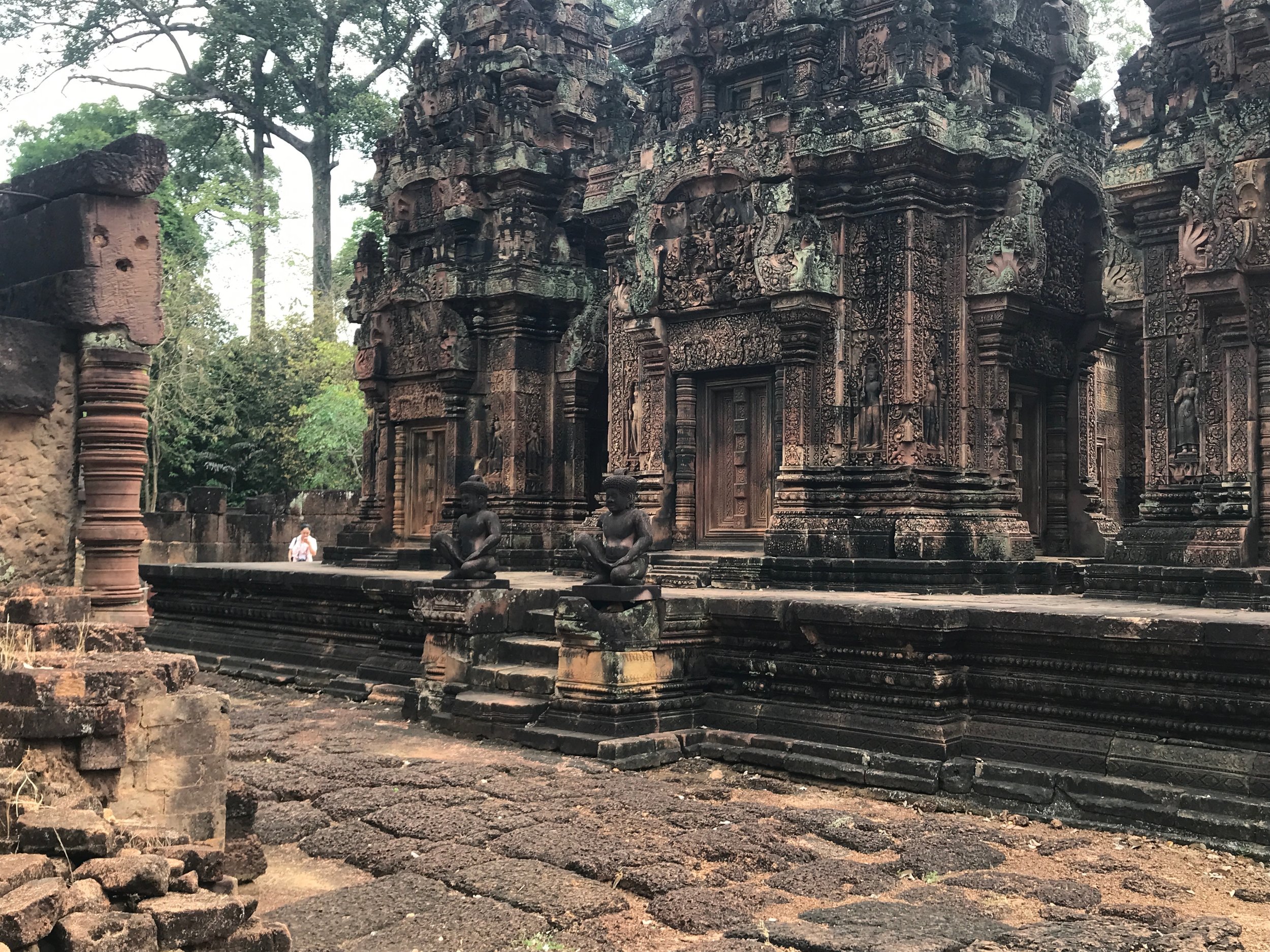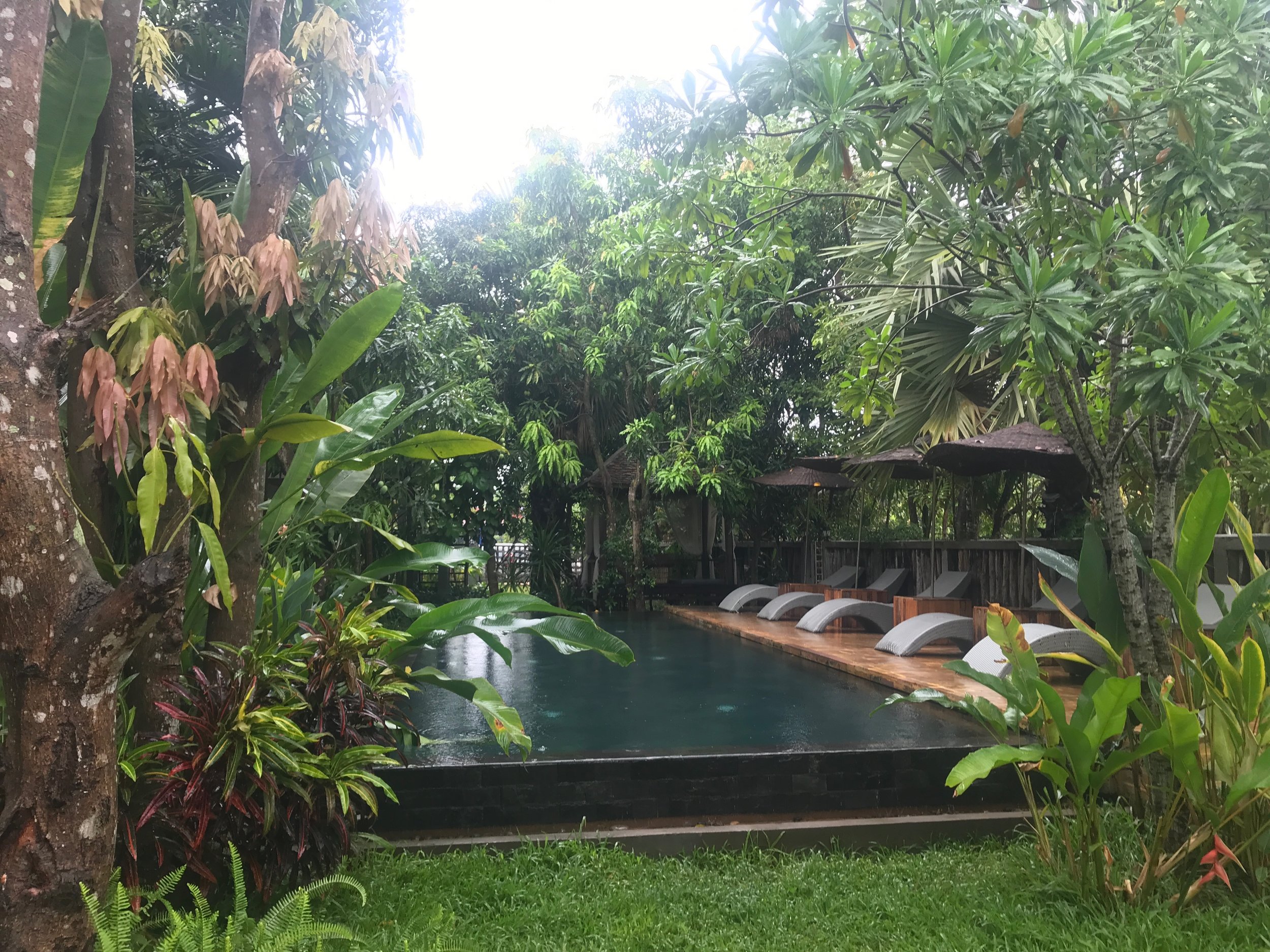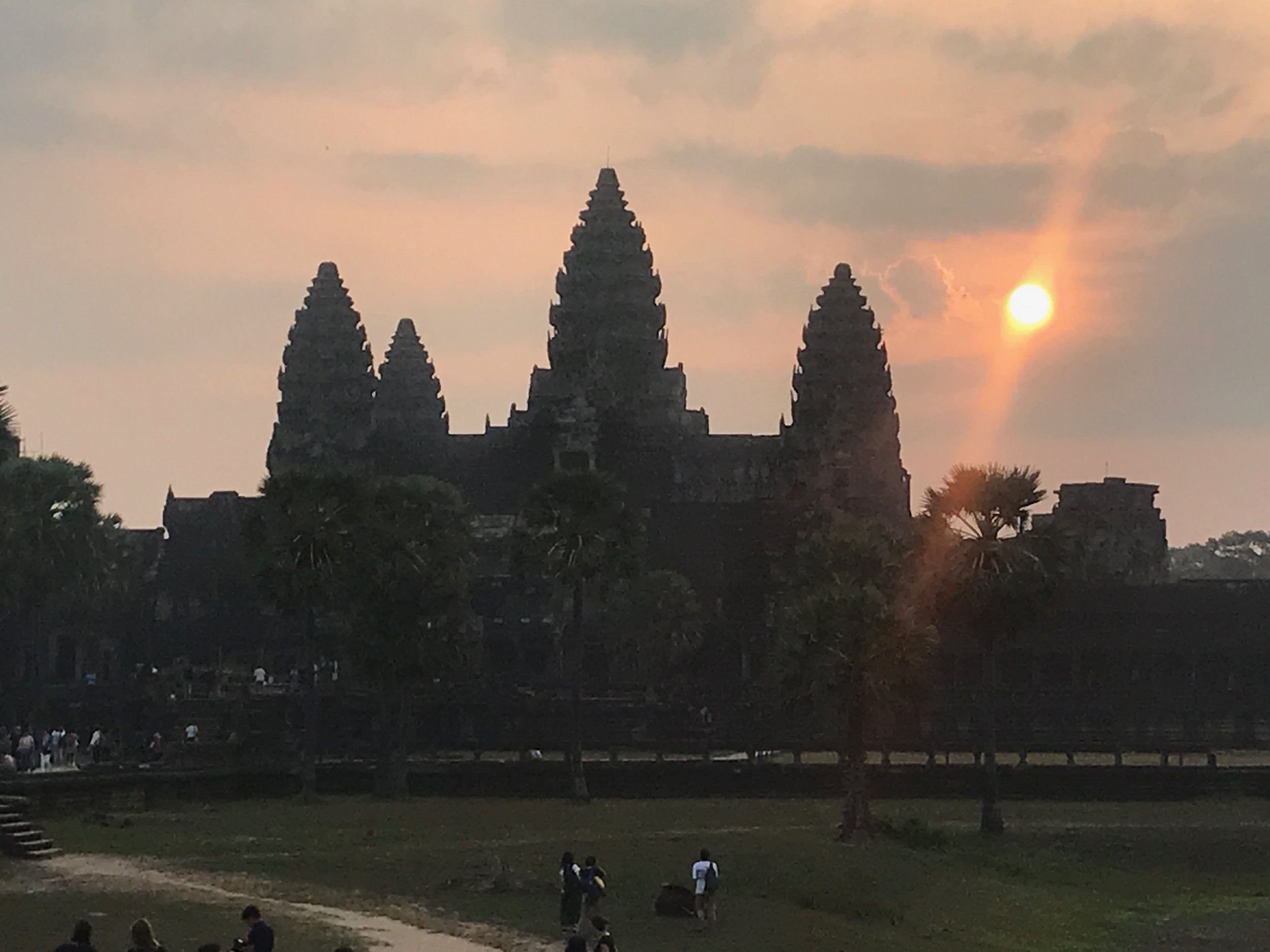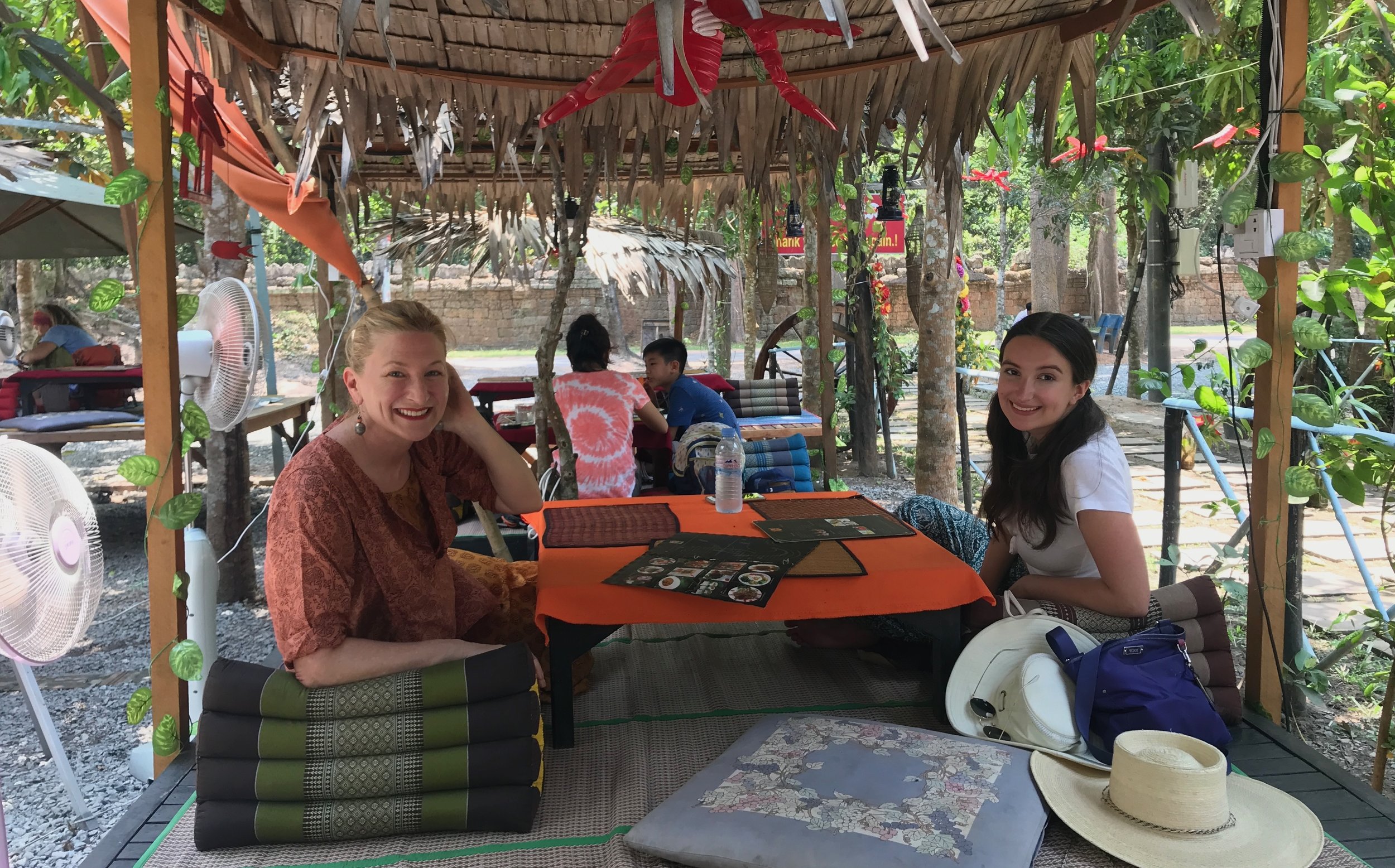Siem Reap, Cambodia: A Land of Ruins and Relics
We land in Siem Reap on a steamy night; it’s 90 degrees and 60 percent humidity. I’m shedding layers as the van pulls up to Jaya House River Park. That’s when Roxy begins to quiz me. “So, you’re telling me we are visiting multiple ancient temples tomorrow, during the day, in this heat or worse, and we aren’t allowed to wear shorts or skirts? she asks. ” I stare back at her and say, “Yes, and we also have to cover our shoulders and knees.” Roxy groans, “Well, if I die of heat exhaustion tomorrow, at least it will be at one of the Seven Wonders of the World.” I laugh, saying “That’s the spirit!”
Roxy and I are greeted by a line of young, handsome Cambodian men holding cold drinks on trays. We humbly accept the refreshing juice and down it in one gulp. “You must be famished!” declares a tall, thin, blonde, blue-eyed man who enters with a flourish. “Let me introduce myself. I'm Christian, the Managing Director of this establishment. I’ve had the kitchen staff prepare croque monsieur and gin and tonics. Will that suit you or would you prefer something else altogether?” I look at Roxy who seams delighted, and say, “Oh, that would be perfect!”
As we sit in the hotel’s chic lobby eating our crispy cheesy sandwiches, Roxy looks up at Christian, clearly curious about our new friend who is an anomaly in this decidedly non-Western country. “Where are you from originally, and how long have you been living in Cambodia?” Roxy asks. “Well, I moved to Cambodia ten years ago. Since then, I’ve turned this little hotel into a museum and I am its curator,” he says proudly. With an eye for personal flair and nostalgic finds, Christian’s collection includes ’80s boomboxes, a Victrola, steamer trunks, transistor radios, and antique clocks. It’s all mixed with a colorful array of modern wooden furniture, Asian artifacts, and simple flower arrangements. It looks like a cross between an expat’s Asian hideaway and a chic New York apartment.
Christian offers to have our laundry washed overnight so we can have clean clothes in the morning. “It’s on the house,” he says with a small bow. With gratitude, we hug our new friend good night and head up to our room. I walk onto the balcony and admire the garden and swimming pool. Lights are shining up on the rich greenery of mature trees which add beautifully to the deep lushness of our Cambodian home base. Roxy and I feel like we belong in this hidden gem, just minutes by canopy-covered tuk-tuk from the majestic, magical temples of neighboring Angkor Wat.
At 5am, Roxy wakes up eager to explore the sites. She prompts me with a “Ready, set, go!” Her attitude blows my sleepiness away, replacing it with anticipation. The hotel has packed a lovely breakfast for us, including super sweet Cambodian coffee to drink after we witness the sun rising over Angkor Wat. After a short ride, we take our place on the cold stone steps of a small temple that faces Angkor Wat. We are joined by well over a hundred people scattered about in the dark, sitting and standing on the grounds of this Hindu-Buddhist icon. We’re all waiting for the moon to disappear and the sun to come up over the right shoulder of the enormous temple.
A little over an hour passes when day breaks and the sun rises over Angkor Wat. The sun floods the sky, setting the palm trees aglow, backlighting the clouds and turning the entire scene pink and yellow. Witnessing the color and drama is the kind of cinematic moment that seals in your memory forever. We hear the other visitors ooh and ah at the mesmerizing event. Our guide Rhett enters the scene and at his prompting, asks us to turn towards him as he snaps pictures of the sun over our shoulders, the temple in the background and those thousand-year-old, sky-scraping palm trees swaying in the Cambodian breeze.
After we eat our breakfast picnic, we ascend stairs designed to make you feel as if you’re climbing to heaven. Thousands of statues greet us outside and inside the three-story devotion to Buddha. Rhett tells us that Angkor Wat was built by a king named Suryavarman II who came to power in his teenage years by killing his great uncle while he was riding an elephant. “As one does,” Roxy quips. Wanting to prove his might, Suryavarman decided to go big by surrounding Angkor Wat with a 650-foot-wide moat that encompasses a perimeter of more than three miles.
Then, we’re off to visit the fortified city of Angkor Thom. First, Roxy and I enter the monumental South Gate over a causeway lined on either side by statues of demons and gods. We view spaces which were once used for public ceremonies: the Terrace of the Elephants and Terrace of the Leper Kings, both adorned with dramatic bas-reliefs. Then, we see the ruins of Baphuon, the Royal Enclosure, and Phikmeanakas before continuing to the unknowable Bayon Temple. We are walking through ancient history, from temple to temple, as Rhett tells us stories about each king, the chronology of the temples’ construction, and the meaning of the dramatic carvings.
We end our day on a high note at Ta Prohm, which looks like a movie set (and it is). Even more mysterious than the others, Ta Prohm is a haunting maze of tumbled-down columns and broken doorways. Fig trees have taken hold of it and grown right into, on top of, and on the side of the stone buildings. The temple was used as a location for the hit film “Tomb Raider,” starring Angelina Jolie. When Rhett tells us this nugget of information Roxy lights up instantly. “Angelina Jolie was here?” Roxy asks excitedly. “Was this pre-or post Brangelina? My money’s on during, because she did adopt a Cambodian child, although that could’ve been with Billy Bob Thornton…” Roxy trails off, deep in contemplation. Rhett laughs, asking, “You really know a lot about Hollywood, huh?”
Back at the hotel, the staff greets us with a heartfelt, “Welcome home.” Smiling, they bow and hand us a cold washcloth, passion fruit juice, and endless service. They make sure we have a tuk-tuk should we need to go out, spray us with natural bug spray, help us cross the road to the river, and give us fresh watermelon to snack on when we come back at the end of the day. Jaya House has got to be one of our favorite hotels of all time, making our stay here in Cambodia sheer perfection.
After a dip in the hotel’s pool, Justin, the hotel’s guest experiences host, takes us to where the locals eat. Christian, the effusive hotelier, tells us that we are in for the treat of a lifetime, one most Americans skip because of an uninformed take on Cambodian street food. But Roxy and I are game, always up for what the locals do--and always hungry! We ride together in the tuk-tuk through busy streets, whizzing past the jungle of cars, people, shops, and through the thick warm air until we come upon a massive night market. Rows of grilled meat, vegetables and clothing take over the grounds that Justin tells us were empty only a few hours ago. Plastic floor mats are spread on the ground and families eat together cross-legged, pulling grilled meat out of banana leaves with their hands. We are the only Westerners.
Off we go to Justin’s favorite grilled meat stall. Skewers are lined up on enormous barbeques weighed down with every kind of meat imaginable. He chooses frog legs, chicken liver, chicken thighs, and other types of meat for us to try. Roxy and I feel like we are inside an episode of Bizarre Foods. We sit on one of the plastic floor mats and marvel at the flavors of this country we are coming to love for its beautiful culture and fascinating cuisine. The frog legs are tender, and the chicken liver is infused with charcoal and spices. “You like it?” Justin asks eager to please. “I love the savory spices on the meat. The taste of everything is so good!” I say.
We head down the line of stalls to a soup stand under a plastic canopy. Justin knows the owner who invites us to sit on tiny plastic stools, our feet spread out under toddler-sized bright red tables. Bowls of spicy soup are put before us. Inside rich steaming broth are intestines, blood clots, and pieces of chicken. We tear fresh herbs from a mound of leafy greens into the soup, slurping and chewing with relish. Roxy nods when Justin asks if she likes it. An American teenager eating the insides of an unidentified animal: That’s my Roxy. After our street food adventure, Justin drops us for a night cap at Miss Wong’s. A little seedy and dazzling all at once, the place looks like a post-war Chinese speakeasy, with its kitschy red lanterns and whimsical 1940s big-band soundtrack. A cast of international characters populate the place making it a great spot for people watching.
The next day, Rhett ferries us one hour north to visit Banteay Srei, a small pink sandstone temple perfectly preserved and carved with filigree. The carvings tell the story of the Rain God for whom the temple was built. Monkey Gods guard the buildings along with a small moat that surrounds the artistic structures. Roxy and I are swept up in its delicate beauty and understand why this temple, completed in 967 A.D., is hailed as the "Jewel of Khmer Art." Back at the hotel, Roxy and I swing together, shoeless, across a small narrow table. We clink glasses of rosé, eating chicken curry and steamed fish in a banana leaf, bowls of rice, fresh bread, a huge fresh green salad, and a grand finale of homemade chocolate ice cream in shot glasses with mint. It’s the best meal we’ve had so far in this country.
Christian encourages us to take a morning walk to the Small Art School. Founded by Tomoko Kasahara, a Japanese arts teacher, the school provides a free art education to Cambodian children, especially to those who have the will to learn, but lack the opportunities to learn. Filling a void of artists and teachers who were killed in-country during the Khmer Rouge regime, the Small Art School has made art accessible to some 400 children in and around Siem Reap. Roxy and I are inspired by the school, the adorable children, and Tomoko’s whole-hearted commitment.
We visit The Cambodia Landmine Museum founded by Aki Ra, a former child soldier. He returned to the killing fields to help the United Nations in clearing landmines with homemade tools and his bare hands. Over a ten-year period, some 50,000 mines and unexploded weapons were cleared and those that are safe are now part of a collection housed in the museum. The display shakes us to the core and reminds us once again of the resiliency of the Cambodian people.
What’s left on the menu? The Cambodian Cooking School. Rhett brings us to a small hotel located on a small organic farm to meet the chef. Young and eager, he is thrilled to teach us how to make green papaya salad, spicy chicken soup, and stir-fried beef. We are equally excited to learn how to attempt the complex Khmer cuisine we’ve been enjoying the past few days. Roxy and I put on chef’s hats and aprons and pretend we’re on an episode of Iron Chef. All of our dishes taste delicious, and we receive certificates of completion and a booklet of recipes. We pack these souveniers in with the memories of the people, their ruins and relics, the colonialists, conquerors and kings that have shaped this country.











